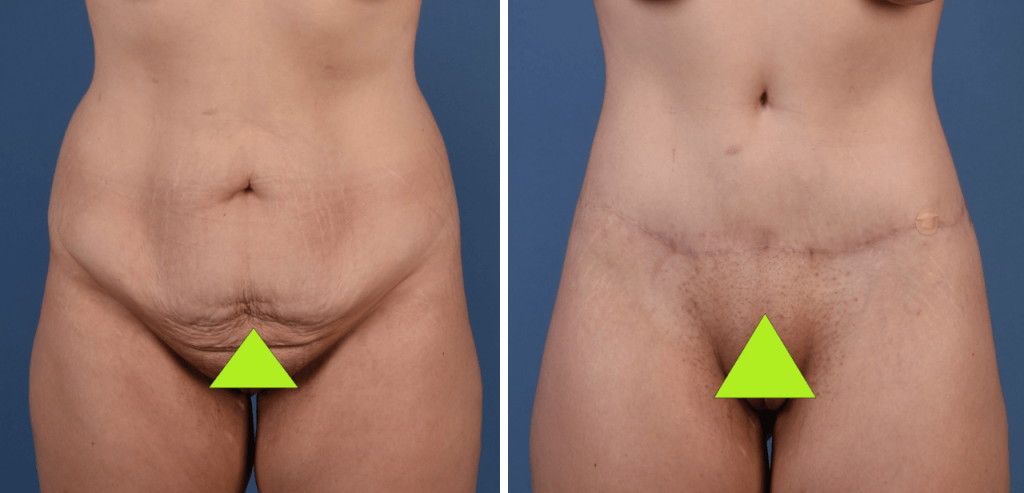5 Minute Read:
Abdominoplasty (tummy tuck surgery) is among the most popular and effective plastic surgery procedures available to women and men. Skin laxity, sagging skin, looseness of the abdominal wall muscles, and stubborn subcutaneous fat in the midsection are all addressed with this procedure.
And while traditional tummy tuck surgery is a fantastic choice for patients looking to transform their appearance, the development of the TULUA technique over the last few years has allowed select patients to achieve the body contours they desire with less extensive surgery and less potential complications.

However, because the TULUA technique is new, few plastic surgeons in the United States use this technique, and most people are not aware of the TULUA abdominoplasty. Dr. Aly brought this technique to the US and its scientific journals.
Below, we will explore the TULUA technique.
What Is the Difference Between TULUA Abdominoplasty and a Tummy Tuck?
Traditional Tummy Tuck
The protrusion of the abdomen, especially when viewed in profile, is due to two main factors:
- External excess skin and fat
- Internal loose and separated six-pack muscle, from the breastbone to the pubic area, which leads to protrusion of the abdominal wall
To get an attractive flat abdomen, both of those issues must be taken care of.
With a traditional tummy tuck, an incision is made just above the pubic area that usually stretches from hip to hip. The skin and fat are then elevated (pulled up) to the ribs and breastbone, exposing the underlying six-pack muscles, separated from the pubic area to the breastbone. The separation is most often caused by pregnancy, weight gain, and subsequent weight loss.
In traditional tummy tucks, the six-pack muscles are sewn back together vertically to flatten out the abdominal wall.

The diagram above demonstrates the typical “vertical plication” performed in a traditional tummy tuck, leading to a flat inner layer. Subsequently, the excess skin and fat are pulled down and trimmed. A belly button is created by making a hole through the stretched skin, and the original belly is brought through and sewn in place.
TULUA Abdominoplasty

While the incision for TULUA is in the same location as a traditional abdominoplasty, the elevation of the skin and fat in a TULUA is only up to the level just above the belly button. In this sense, the upper abdomen (the area above the belly button) is exposed to less surgical manipulation.
The area above the belly button is then liposuctioned to reduce fat and allow the skin and fat to be pulled down to the level of the incision. The native belly button is sacrificed as a new one will be made at the end, after closing the wound.
With the TULUA technique, liposuction is used on the abdomen and surrounding areas (including the hips, flanks, back, and pubis), specifically focusing on removing fat in the upper abdomen, which helps reduce the risk of skin and fat dying.
One of the major differences between the traditional tummy tuck technique and TULUA abdominoplasty is that a “horizontal plication” (tightening of the abdominal wall) is used in the TULUA technique instead of the vertical plication shown above.
The figure below shows the pattern used by Dr. Aly to mark out the area to be brought together. In this technique, the lower three lines are sutured to the upper horizontal line, significantly tightening the abdominal wall, decreasing the vertical distance, and flattening the inner layer.

Next, the excess skin and fat from the level of the belly button to the lower incision are removed, and the abdomen is closed. At this point, a new belly button is created in the best position to create an attractive and appealing tummy, rather than using the old belly button.
What Are the Benefits of the TULUA Technique?
In short, TULUA abdominoplasty offers a safer method while providing equivalent results to traditional tummy tuck surgery. This surgery is less invasive than a traditional tummy tuck since the skin and fat flap are only pulled to the belly button, not the chest area.
Because the flap is not pulled as far up on the body, there is a much-reduced chance of skin and fat dying, which is a risk with traditional tummy tuck surgery.
Additionally, because the belly button must be recreated, you can ensure it is in the best location possible.

Above, you see the preoperative and postoperative pictures of a patient who utilized the TULUA technique. Note the refinement of the outline of her six-pack muscle, the improvement of waist definition, the ideal positioning of the belly button, and the elevation of the pubic area.
To summarize, the advantages of the TULUA technique are:
- It produces results equal to or better than traditional tummy tucks with less overall surgical manipulation and risk.
- It utilizes liposuction to refine the results.
- In the well-selected patient, the horizontal plication is as good as the vertical plication in tightening the abdominal wall.
- It allows the surgeon to place the belly button where it will create the best possible abdominal contour.
Not every patient is a good candidate for a TULUA Technique. Specifically, patients with a wide separation of the six-pack muscles above the level of the original belly button would not be amenable.
In the End …
TULUA abdominoplasty is not as common as traditional tummy tuck surgery because it is new. Only a handful of experienced cosmetic surgeons (like Dr. Aly) are knowledgeable and skilled enough to perform the procedure. However, the TULUA technique can be your answer to achieving the tighter and trimmer core you have always wanted.
Want to Learn More?
If you are interested in TULUA abdominoplasty or any body contouring procedure that Dr. Aly offers in and around Dallas, Texas, then schedule a consultation today by calling 214-645-3213 or filling out our online contact form.
